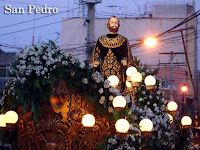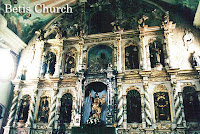 Pampanga is a culture of contrasts, where the genteel elegance of the olden days collides with folk traditions. And the City of San Fernando on Good Friday is an embodiment of that clash, where both cultures come alive in their own ritualistic and colorful displays of faith.
Pampanga is a culture of contrasts, where the genteel elegance of the olden days collides with folk traditions. And the City of San Fernando on Good Friday is an embodiment of that clash, where both cultures come alive in their own ritualistic and colorful displays of faith. I had to be in San Pedro Cutud before 11 a.m. so that I could watch the Via Crucis, a Kapampangan passion play written in the 1950s which began the crucifixion frenzy that has put San Fernando on the global map. While driving, I was surprised to see so many people lining MacArthur Highway. Then I remembered that there was also a group which made its way around our area and we would also wait for them to pass by when I was a small kid. I wonder how the guy survived all the pushing and the hitting.
I had to be in San Pedro Cutud before 11 a.m. so that I could watch the Via Crucis, a Kapampangan passion play written in the 1950s which began the crucifixion frenzy that has put San Fernando on the global map. While driving, I was surprised to see so many people lining MacArthur Highway. Then I remembered that there was also a group which made its way around our area and we would also wait for them to pass by when I was a small kid. I wonder how the guy survived all the pushing and the hitting. In Pampanga, penitents are called magdarame. There are specific names for various types such as mamalaspas or those who flagellate themselves, mamusan krus for the cross-bearers, magsalibatbat for those who crawl on dirt roads, at times under the hot summer sun, and cristos which refers to those who have themselves nailed on crosses.
In Pampanga, penitents are called magdarame. There are specific names for various types such as mamalaspas or those who flagellate themselves, mamusan krus for the cross-bearers, magsalibatbat for those who crawl on dirt roads, at times under the hot summer sun, and cristos which refers to those who have themselves nailed on crosses.Anyway, I was expecting heavy traffic in Cutud by this time so I parked my car in the poblacion and took a pedicab to the crucifixion area. You'd be surprised by the number of foreign tourists who attend. On the way, I saw many of them in vehicles with diplomatic plates and all. As always, I forgot to bring my hat and now I have to deal with a badly sunburned face.
 If you could not stand the sight of blood, Cutud is just not for you. On the way, you have dozens of flagellants making their way to the crucifixion site as well and it's close to impossible to keep your clothes blood free. As they whip themselves, blood would definitely splatter and it's very difficult to move around to avoid getting hit.
If you could not stand the sight of blood, Cutud is just not for you. On the way, you have dozens of flagellants making their way to the crucifixion site as well and it's close to impossible to keep your clothes blood free. As they whip themselves, blood would definitely splatter and it's very difficult to move around to avoid getting hit.Don't be surprised too if you see everyone eating pork along the way. Bantayan Island is not the only place in the Philippines allowed to eat meat on Good Friday. Today is one of two fiestas celebrated annually in San Pedro Cutud and they've been granted dispensation too!
 People do not realize that there is history in the Cutud crucifixions. It may be imitated in other parts of Pampanga and the Philippines, but the Via Crucis is something that makes it culturally significant. It is the only Kapampangan language passion play and it has been done non-stop since the 1950s with the first crucifixion in San Pedro.
People do not realize that there is history in the Cutud crucifixions. It may be imitated in other parts of Pampanga and the Philippines, but the Via Crucis is something that makes it culturally significant. It is the only Kapampangan language passion play and it has been done non-stop since the 1950s with the first crucifixion in San Pedro.The crucifixions start as soon as the Via Crucis makes its way to the hill after going around San Pedro Cutud. This is the only passion play in the entire world where the players are really nailed to the cross. It actually starts with the arrest at the entrance of the barangay. Then several scenes are reenacted around the barangay culminating with the crucifixion in the hill.
 Stretchers are on standby, waiting for the penitent to signal the centurions to bring him down. After the first three are finished, the next set prepares to mount the cross. You could hear shrieks from the crowd as they watch the designated spotters hammer the nails into the hands and feet of the penitents. It may look foolish to many but these are acts of faith. Referred to as panata in Kapampangan, these are vows made by the penitents in the hope that their prayers will be answered.
Stretchers are on standby, waiting for the penitent to signal the centurions to bring him down. After the first three are finished, the next set prepares to mount the cross. You could hear shrieks from the crowd as they watch the designated spotters hammer the nails into the hands and feet of the penitents. It may look foolish to many but these are acts of faith. Referred to as panata in Kapampangan, these are vows made by the penitents in the hope that their prayers will be answered.I realized it was already 2 p.m. when it ended. My stomach was already grumbling since I hadn't eaten breakfast. The Via Crucis started late this year and thus ended late. Two years ago, it was done before 1 p.m. so the best time really to be there is 11 a.m. And expect to walk a long distance from the welcome arch of the barangay to the crucifixion site.
 For the afternoon, I visited relatives in the different old houses as they were preparing their santos for the Good Friday procession. This was the other half of the clashing cultures I was referring to. There was so much to eat but I kept my food intake down since I was fasting today. I just had some home-made pastries for my late lunch and sampelut (ginataan) for a snack in another house. Dinner was just pako (fiddlehead fern) salad and buko sherbet. To see photos of the food we ate, visit the blog of Mike Mina.
For the afternoon, I visited relatives in the different old houses as they were preparing their santos for the Good Friday procession. This was the other half of the clashing cultures I was referring to. There was so much to eat but I kept my food intake down since I was fasting today. I just had some home-made pastries for my late lunch and sampelut (ginataan) for a snack in another house. Dinner was just pako (fiddlehead fern) salad and buko sherbet. To see photos of the food we ate, visit the blog of Mike Mina. By 4 p.m., the carrozas slowly made their way to the Cathedral. When I got to the plaza, it was already hard to move around. I am amazed by the sheer volume of people who join the Good Friday procession in San Fernando. Add to that the many grand heirloom carrozas and santos, it's really a sight to behold.
By 4 p.m., the carrozas slowly made their way to the Cathedral. When I got to the plaza, it was already hard to move around. I am amazed by the sheer volume of people who join the Good Friday procession in San Fernando. Add to that the many grand heirloom carrozas and santos, it's really a sight to behold.Notice also that all the santos are in black. During the Holy Wednesday procession, they are dressed in their symbolic colors. But come Good Friday, they all wear black vestments as a sign of mourning.
 When you stand in one area to take photos, you get to say hello to countless friends, relatives and acquaintances who pass by. I saw blogger Spanky Enriquez of the Hizon Clan who owns the image of San Pedro.
When you stand in one area to take photos, you get to say hello to countless friends, relatives and acquaintances who pass by. I saw blogger Spanky Enriquez of the Hizon Clan who owns the image of San Pedro. Anyway, the procession took close to two hours to complete. By the time it finished, I was just so wasted. Imagine having to endure three hours under the scorching summer sun followed by a long walk of several kilometers around the poblacion for the procession. I think I really need some rest.
Anyway, the procession took close to two hours to complete. By the time it finished, I was just so wasted. Imagine having to endure three hours under the scorching summer sun followed by a long walk of several kilometers around the poblacion for the procession. I think I really need some rest.Related entry
Crucifixion rites held in San Pedro Cutud every Good Friday
Holy Week practices in the Philippines
Visita iglesia to our heritage churches






